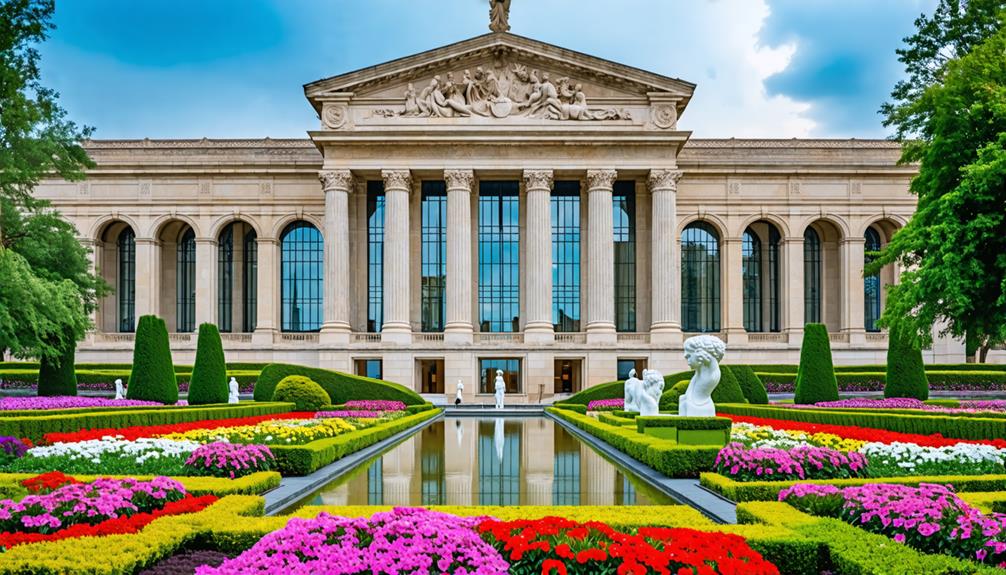When you visit the Nelson-Atkins Museum of Art in Kansas City, you immerse yourself in a cornerstone of cultural heritage that has been integral to the community since its inauguration in 1933.
The museum's striking architectural synthesis of neoclassical elements and modern design, characterized by imposing Greek columns alongside broad glass facades, creates a visually stimulating environment.
Inside, the museum houses a diverse and meticulously curated collection that ranges from ancient artifacts to modern art, showcasing works by luminaries such as Caravaggio, Rembrandt, and Monet, alongside significant Asian art pieces and contemporary installations by artists like Sarah Sze.
The Nelson-Atkins is committed to education and enrichment, offering a variety of programs and dynamic special exhibitions that ensure every visit offers a new perspective, deepening visitors' connections to art and culture with each experience.
Key Takeaways
- Founded in 1933, the Atkins Museum in Kansas City stands as a pivotal institution showcasing a wide array of artworks from different periods.
- The museum is renowned for its architectural design that marries classical and contemporary styles, notably highlighted by the Bloch Building, designed by Steven Holl.
- Its collection boasts significant pieces from artists such as Caravaggio, Rembrandt, and Monet, alongside modern works from Kehinde Wiley and Nick Cave.
- The Atkins Museum is accessible from Tuesday through Sunday, charging an admission fee of $12 for adults, while children under 12 enjoy free entry.
History of the Museum
Established in 1933, the Atkins Museum of Kansas City embodies the city's cultural progression. The foundation of the museum was laid with an unwavering dedication to preserving art and culture, a vision supported by local philanthropists who valued a cultural epicenter in their community.
At its core, the Atkins Museum has consistently emphasized community involvement. This engagement is evident in its diverse range of programs, exhibitions, and events designed to make art accessible and instill a communal sense of pride and ownership.
Over the decades, the museum has dynamically evolved, incorporating feedback from Kansas City residents to better serve and reflect its audience. Whether through workshops, special exhibitions, or community projects, the museum illustrates the transformative role of community input in shaping cultural institutions.
The Atkins Museum stands as a testament to the enduring influence of community collaboration in the arts, continually adapting to fulfill the cultural needs and aspirations of its visitors.
Iconic Architecture
The Atkins Museum's architecture is a masterful synthesis of tradition and innovation. Its majestic columns and detailed carvings draw inspiration from classical artistry, evoking a sense of historical depth and cultural significance.
In contrast, the modern elements, such as expansive glass windows, infuse the structure with a sense of openness and contemporary relevance.
This architectural dialogue between the past and present not only captivates the eye but also stimulates a deeper appreciation for the blending of different eras.
The museum stands as a symbol of how historical influences can seamlessly integrate with modern design, fostering a unique cultural and aesthetic experience.
Historical Design Influences
The Nelson-Atkins Museum of Art in Kansas City serves as a testament to the enduring influence of both classical and contemporary architectural styles, merging historical aesthetics with modern innovation. This architectural synthesis not only respects cultural heritage but also enhances the museum's role as a custodian of artistic evolution.
| Design Element | Influence Source |
|---|---|
| Greek Columns | Classical Antiquity |
| Art Deco Facades | Early 20th Century |
| Grand Staircases | Victorian Era |
| Minimalist Interiors | Modernism |
As you traverse the museum, the presence of Greek columns not only supports the structure physically but also spiritually, invoking the enduring beauty and intellectual rigor of classical antiquity. The elegant Art Deco facades reflect the optimism and decorative finesse of the early 20th century, inviting contemplation of a pivotal artistic era.
The interior features grand staircases that recall the opulent design of the Victorian era, each step enhancing the theatricality and exploratory promise of the museum's expansive collections. In contrast, the minimalist interiors speak to modernist ideals of simplicity and functional beauty, creating a calm backdrop that foregrounds the art itself.
This architectural melange at the Nelson-Atkins Museum of Art not only celebrates but also narrates a dialogue between epochs, underscoring the museum's commitment to cultural stewardship and aesthetic education. Through its design, the museum embodies the essence of historical reverence and forward-thinking creativity, making it a pivotal institution in the cultural landscape.
Modern Architectural Features
The Nelson-Atkins Museum of Art, with its deep historical roots, also features the Bloch Building—an epitome of modern architecture designed by Steven Holl. This addition isn't only a nod to sustainability through its use of natural light captured by glass lenses, thereby diminishing the reliance on artificial lighting, but it also marks a seamless integration of past and present. The design's commitment to environmental sustainability aligns with contemporary values, enhancing the museum's appeal and responsibility towards energy efficiency.
Surrounding the museum, the thoughtfully curated landscapes serve as a bridge connecting the institution with the community. This urban integration fosters a sense of inclusivity and openness, inviting both visitors and locals to engage with the space. The expansive lawns and outdoor sculptures create an inviting atmosphere, encouraging extended interaction with art in its various forms.
Internally, the museum's modern galleries offer a spacious and light-filled environment ideal for showcasing contemporary art. The innovative use of materials and architectural principles ensures that the museum is a leading example of architectural brilliance. By blending historical elements with futuristic design, the Nelson-Atkins Museum of Art not only safeguards its heritage but also adapts to contemporary cultural dynamics, making it an essential destination for those passionate about art and architecture.
Art Collections Overview
At the Atkins Museum, visitors are immersed in a curated collection that spans various artistic eras, reflecting the museum's commitment to art historical diversity and scholarly rigor.
Each piece, carefully selected for its significance and impact, invites admiration and contemplation.
The museum's excellence in curation ensures that each artwork is contextualized, enhancing the viewer's understanding and appreciation.
This approach not only preserves the integrity and trustworthiness of the art but also fosters an emotional and intellectual connection, enriching the cultural dialogue among its audience.
Diverse Artistic Periods
At the Atkins Museum KC, the art collections span centuries, weaving a narrative that reflects the evolution of human expression from ancient times to the contemporary era. As you explore, you'll encounter artworks that aren't just visually striking but also deeply embedded with the cultural, social, and political contexts of their times.
From the Renaissance, where a revival of classical learning and wisdom underpins the artworks, to the daring innovations of the 20th century, each piece serves as a historical document and a source of inspiration. The dramatic flair of the Baroque period and the ornate aesthetics of Rococo are vividly contrasted with the earnest realism of the 19th century. These styles, each responding to the unique demands and sensibilities of their time, offer insights into the shifts in societal values and technological advancements.
Impressionist paintings, with their emphasis on light and movement, signify a break from the conventional constraints of art, mirroring the broader liberation movements within society at the time. Each artwork in the museum thus acts as a portal to the past, offering a glimpse into the collective psyche of different eras and the ongoing dialogue between generations of artists.
Notable Masterpieces Displayed
Within the walls of the Atkins Museum KC, visitors traverse through a timeline of artistic evolution, marked by pivotal works that underscore the museum's commitment to cultural preservation.
A notable highlight is Caravaggio's 'John the Baptist,' a masterpiece renowned for its poignant chiaroscuro — the dramatic interplay of light and shadow not only captivates viewers but also symbolizes the spiritual struggles depicted in the painting. This piece, emblematic of the Baroque period, enriches the collection and offers a deep dive into historical artistic endeavors.
The museum also celebrates the fusion of personal and creative forces in the works of Diego Rivera and Frida Kahlo. Their paintings, born from a partnership infused with passion and tumult, reflect deep socio-political commentary intertwined with rich Mexican traditions. These works not only provide a visual feast but also invite contemplation on love, pain, and resilience, resonating with viewers on multiple emotional and intellectual levels.
In the realm of contemporary art, Yayoi Kusama's 'Infinity Mirror Room' stands out as a must-experience installation. This immersive exhibit, a labyrinth of endless reflections, encapsulates Kusama's exploration of the infinite and the minuscule within the universe. It offers not just a spectacle for the eyes but also a space for introspection, drawing visitors into a visceral engagement with the concept of self and the cosmos.
Each piece within the museum is meticulously chosen not only for its aesthetic appeal but also for its ability to communicate across cultures and epochs, ensuring a profound impact on a diverse audience.
Thus, the Atkins Museum KC serves as a custodian of both beauty and dialogue, bridging past and present through the universal language of art.
Curatorial Excellence Highlights
The curatorial team at the Atkins Museum KC excels in crafting a diverse and engaging collection that spans multiple art movements and cultural narratives. Their practices are both innovative and meticulous, ensuring that each exhibition connects deeply with visitors.
As you walk through the museum, you'll experience how their exhibition strategies enhance your engagement. The team combines traditional and contemporary methods to craft immersive environments that encourage deep interaction with the art.
Here's what you can expect:
- Thematic Exhibits: These exhibitions are thoughtfully organized around central themes, making complex subjects accessible and captivating. They allow you to delve into specific ideas or historical periods, enhancing your understanding and engagement with the art.
- Rotating Collections: The continual refreshment of displays ensures that there's always something new to encounter, keeping the museum lively and inviting frequent visits.
- Interactive Installations: These installations engage you as an active participant, transforming the art experience from passive observation to active involvement. This interactive approach deepens your appreciation and understanding of the artworks.
These strategies not only reflect the museum's commitment to educational enrichment and cultural enrichment but also foster a deeper connection between the art and its audience. The Atkins Museum KC's approach ensures that each visit isn't only a journey through art but also an emotionally and intellectually enriching experience.
European Masterpieces
The Atkins Museum KC houses a stunning array of European masterpieces, representing a journey through the continent's rich artistic history from the Renaissance to the modern era. Each artwork, whether a painting by Rembrandt or a sculpture by Rodin, stands as a testament to the artists' mastery over form, emotion, and technique. The interplay of light and shadow, the precise detail, and the innovative compositions not only showcase the artists' technical skills but also evoke a deep emotional response.
Experiencing the works of Van Gogh, Monet, and Vermeer at the museum highlights the transformative periods of European art and underscores its profound influence on global culture. These pieces not only offer visual delight but also invite reflection on the societal and cultural contexts that shaped them.
For both art lovers and casual visitors, the European masterpieces at the Atkins Museum KC are a source of inspiration and a window into the soul of Europe's artistic heritage.
Asian Art Highlights
Visit the Asian Art exhibit at the Atkins Museum KC and immerse yourself in the rich artistic traditions that span centuries and cross multiple cultures. Each artifact narrates the unique heritage and cultural significance of its origins. The collection is a testament to the intricate connections between art, history, and identity across Asia.
Highlighted sections include:
- Chinese Ceramics: Experience the refined beauty of Ming dynasty ceramics, renowned for their sophisticated blue-and-white patterns. These pieces aren't merely artistic expressions but also historical relics that offer a glimpse into the rich tapestry of China's history.
- Indian Sculptures: Explore the intricate carvings of Hindu deities, where each figure is imbued with deep symbolism and cultural importance. Crafted in stone and bronze, these sculptures provide a profound insight into India's spiritual and artistic traditions.
- Japanese Woodblock Prints: Delve into the world of ukiyo-e prints, which illustrate the vibrant cultural life of Japan's Edo period. These prints, depicting landscapes, kabuki actors, and everyday scenes, highlight the exceptional skills of Japan's master printmakers.
Each piece in the Asian Art collection serves as a cultural bridge, offering insights into the diverse and interconnected histories of Asian cultures. This emphasizes the role of art as a medium for cultural expression and identity.
Modern and Contemporary Art
In the Modern and Contemporary Art section of the Atkins Museum, immerse yourself in the avant-garde works of pivotal contemporary artists who redefine artistic boundaries.
This collection showcases movements that revolutionize traditional aesthetics and provoke thoughtful introspection.
Experience this transformative art that resonates with cultural, emotional, and intellectual currents of our time.
Key Contemporary Artists
At the Atkins Museum in Kansas City, a selection of the most influential contemporary artists are showcased, each challenging conventional views and sparking meaningful conversations through their pioneering creations. This museum is dedicated to highlighting both emerging talents and local artists, providing them with a vital platform to share their distinctive insights with a wider audience.
Among the must-see works, you'll encounter:
- Sarah Sze: Renowned for her elaborate installations, Sze masterfully arranges commonplace items to craft absorbing spaces that blur the lines between the tangible and the transient. Her artworks encourage an introspection on the transformation of ordinary objects into extraordinary spectacles, prompting a reevaluation of our everyday surroundings.
- Nick Cave: A celebrated local artist, Cave's ‘Soundsuits' are an amalgamation of sculpture, costume, and performance art. These exuberant, wearable artworks not only captivate visually but also address pressing social concerns, thereby enriching the observer's understanding of both cultural and personal identities through a multisensory experience.
- Kehinde Wiley: Wiley's compelling portraits, which place African-Americans in the regal poses typically reserved for Old Masters, critique historical narratives and elevate contemporary Black culture. His paintings not only challenge the conventional representations in art history but also invite viewers to reconsider the narratives perpetuated through visual arts.
These artists exemplify how contemporary art can extend beyond mere aesthetics, acting as a catalyst for social change and personal reflection, thereby enriching our cultural dialogue and understanding.
Innovative Artistic Movements
Modern and contemporary art movements have revolutionized the way we perceive and engage with the world, often pushing the boundaries of tradition and sparking innovative thinking. At the Atkins Museum, a broad array of exhibitions showcases these dynamics, with a particular focus on artistic collaborations and cultural convergences.
Within the museum, artistic collaborations unite diverse talents and viewpoints, igniting creativity across various genres and mediums. These collaborations are particularly notable for their cultural convergences, where artists from different backgrounds blend their unique experiences to create unified artworks. This synthesis results in art that resonates widely, crossing geographical and societal barriers.
Here's an overview of some pivotal movements and their defining features:
| Movement | Characteristics | Example Artists |
|---|---|---|
| Abstract Expressionism | Focus on spontaneous, automatic expressions of emotion | Jackson Pollock, Mark Rothko |
| Pop Art | Fusion of popular culture and fine art | Andy Warhol, Roy Lichtenstein |
| Minimalism | Emphasis on purity of form and simplicity | Donald Judd, Frank Stella |
These movements, through their distinct styles and approaches, invite viewers to explore a range of emotional and intellectual responses, reflecting societal values and personal experiences. This thematic diversity not only enriches the cultural landscape but also fosters a deeper understanding and appreciation of the transformative power of art.
Sculpture Garden
Tucked away within the verdant expanse of the Atkins Museum, the Sculpture Garden serves as a tranquil sanctuary adorned with a captivating collection of sculptures. As visitors meander through this open-air gallery, they encounter a diverse assortment of sculptures that stir the imagination and awaken the senses. The garden features abstract pieces, lifelike representations, and kinetic art, each strategically placed to achieve a harmonious balance with the natural environment.
The offerings include:
- Abstract Sculptures: These sculptures invite viewers to explore and interpret unconventional shapes and forms, prompting a reevaluation of visual perceptions.
- Figurative Works: Representing human and animal figures with remarkable realism, these sculptures evoke reflections on the deeper narratives embodied by the forms.
- Kinetic Art: Engaging and unpredictable, these pieces use movement, often powered by natural forces like wind, to create an interactive experience that enhances the dynamic quality of the garden.
The thoughtful arrangement of the sculptures ensures that each piece enhances its natural setting, while strategically placed benches offer secluded spots for contemplation.
The Sculpture Garden at the Atkins Museum isn't merely a display of artistic creations; it's a fusion of art and nature that provides a peaceful respite from the bustling world outside, inviting visitors to immerse themselves in a blend of aesthetic beauty and natural tranquility.
Special Exhibitions
The Sculpture Garden offers a tranquil retreat, while the museum's Special Exhibitions present an ever-changing array of artworks from around the globe, blending contemporary with historical influences.
These exhibitions are designed to stimulate dialogue and reflection, featuring interactive elements, multimedia installations, and immersive environments that captivate all senses.
The Atkins Museum collaborates with international artists, institutions, and curators, ensuring its position at the vanguard of the global art scene.
These partnerships enable the museum to showcase a diverse range of art, from Renaissance masterpieces to avant-garde digital works, ensuring that each visit offers a fresh and engaging experience.
Complementing the exhibitions, the museum organizes special events like artist talks, panel discussions, and live performances.
These events deepen the visitor's engagement and understanding of the art on display, enriching the cultural experience.
Each visit to the Atkins Museum becomes a unique journey through the rich tapestry of global artistry, encouraging a deeper connection with the vibrant world of art.
Educational Programs
The Atkins Museum's educational programs are meticulously designed to enrich the experience of visitors of every age group, driving a deeper appreciation and understanding of art through a variety of interactive and immersive activities.
These programs are carefully crafted to cater to different interest levels, from children to adults, fostering a vibrant and engaging learning atmosphere.
Here are three primary components of the educational offerings:
- Hands-on Workshops: In these creative sessions, participants work under the guidance of skilled artists to craft their own artworks. These workshops encompass a range of artistic mediums, offering a tactile exploration of diverse artistic techniques and expressions, thus nurturing individual creativity and technical skills.
- Guided Tours: Conducted by well-informed docents, these tours delve deep into the museum's collections and current exhibitions. Participants gain enriched perspectives and intimate stories about the artworks and their creators, which magnify their knowledge and appreciation of the art.
- Interactive Activities: Designed to be both fun and informative, these activities include scavenger hunts and digital interactive programs that make art accessible and engaging, encouraging participants to discover and connect with artworks in innovative ways.
The comprehensive nature of the Atkins Museum's educational initiatives ensures that each visitor, regardless of age or background, finds meaningful and enriching opportunities to engage with art, promoting a lifelong passion and appreciation for the arts.
These programs reflect the museum's commitment to educational excellence and cultural enrichment, reinforcing its role as a pivotal institution in the arts community.
Visitor Information
To ensure a seamless and enjoyable visit to the Atkins Museum, here are the key details you need to know. The museum welcomes visitors from Tuesday to Sunday, operating from 10 AM to 5 PM, except for Thursdays when doors remain open until 9 PM. Note that the museum is closed on Mondays and major holidays.
Admission costs are budget-friendly: adults pay $12, while seniors aged 65 and above are charged $10. Admission is complimentary for children under 12, making it an ideal spot for family outings. Students presenting a valid ID and active military personnel benefit from a reduced fee of $8. Membership holders enjoy free entry, which enhances the attractiveness of museum membership.
The Atkins Museum is fully accessible, equipped with wheelchair ramps, elevators, and bathrooms designed to accommodate all visitors. Service animals are also welcomed, ensuring that those with special needs can explore the exhibits without hindrance. Parking is plentiful, including spots specifically reserved for visitors with disabilities, ensuring convenience for all.
These thoughtful accommodations and the museum's commitment to accessibility reflect its dedication to providing an inclusive cultural experience for all visitors. Whether you're a solo explorer, a family, or a group with diverse needs, the Atkins Museum is structured to ensure that your cultural enrichment is both effortless and enriching.
Frequently Asked Questions
Are There Any Interactive Exhibits Suitable for Children at the Museum?
Yes, the museum offers a variety of interactive exhibits and programs specifically designed for children.
These features actively engage young visitors in the arts through hands-on experiences that stimulate their creativity and curiosity.
Tailored to various age groups, these programs include workshops and activities that are both fun and educational.
This approach not only enriches children's understanding and appreciation of art but also fosters a lifelong connection to the arts.
Is the Museum Accessible for Visitors With Disabilities?
The museum is fully equipped to ensure accessibility for all visitors, including those with disabilities.
With ramps, elevators, and visitor assistance readily available, the museum ensures that everyone, regardless of their physical abilities, can comfortably navigate and enjoy the exhibits.
The thoughtful design and inclusivity reflect a commitment to providing a welcoming and enriching experience for all guests, underlining the museum's role as a community and cultural center that values diversity and accessibility.
Does the Museum Offer Any Membership Benefits or Discounts?
Certainly, the museum provides a variety of membership tiers, each offering a suite of enriching benefits.
As a member, you gain privileged access to exclusive events, advance previews of upcoming exhibitions, and specialized tours, enhancing your cultural engagement and appreciation.
Members also benefit from discounts at the museum's shop and café, adding value to each visit.
Moreover, membership may include reduced or complimentary entry to a network of associated institutions, broadening your access to cultural treasures.
Are There Any Dining Options Available Within the Museum?
Yes, the museum features an inviting café that enhances your visit by offering a variety of delectable dining options.
Whether you're looking to recharge with a light snack or indulge in a more substantial meal, the café caters to diverse tastes and dietary preferences, ensuring that every visitor finds something to enjoy.
This culinary stop not only complements your educational experience but also adds an element of pleasure, making your time at the museum both enriching and enjoyable.
Don't overlook the opportunity to treat your taste buds while exploring the exhibits!
Can I Take Photographs Inside the Museum?
You're permitted to take photographs inside the museum, subject to adherence to specific photography guidelines aimed at preserving the artwork.
Common restrictions include bans on flash photography and the use of tripods, as these can potentially harm the exhibits.
It's advisable to look out for any signs indicating photography rules or to inquire with museum staff about photography in particular sections.
Conclusion
The Atkins Museum in Kansas City offers a rich tapestry of artistic expressions that span across continents and eras. It houses an exquisite collection of European art, tranquil Asian artworks, and a thoughtfully curated sculpture garden.
Each visit is enhanced by diverse special exhibitions and comprehensive educational programs, ensuring a fulfilling experience for both art connoisseurs and occasional visitors. The museum not only showcases art but also serves as a cultural nexus, fostering a deeper appreciation for the myriad ways in which art enriches our lives.
Make plans to explore the museum's captivating displays and allow yourself to be transported into a world of artistic diversity and cultural dialogue.







